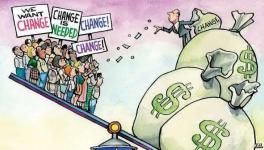“We Paint Because We Believe in the People”

‘We paint because screaming is not enough and
neither crying nor rage is enough.
We paint because we believe in the people and
because we will conquer defeat’
(adapted from the poem, ‘Why we sing’, by Mario Benedetti)

<Greta Acosta Reyes (Cuba), Neoliberalism, 2020>
When they really, urgently, desperately need to say something, the people don’t wait for designers. They get on with it, producing posters and handbills as best they can – sometimes with spectacular results. In the process, they too become designers, organic to their movements, communities, and contexts. The posters in Anti-Imperialist Poster Exhibition II: Neoliberalism run the gamut, from those created by trained designers to those by self-taught artists, from those by activists without formal training to first-timers.
Charmingly, the posters exhibit a variety of artistic and design styles. From the minimalism of Choo Chon Kai (Parti Sosialis Malaysia, Malaysia) to the bustling illustrations of Miguel Guerra (Utopix, Venezuela), from the comic book approach of Roland Nalukoma Cubaka (Congo Love, Democratic Republic of Congo) to the elegant typography of Nancy Naser Al Deen (Lebanon), there is something about each poster that evokes the culture it was created in.
While the poster has been a weapon in the struggle of the oppressed all over the world, there are few places that have developed this tradition into a great art and science as Cuba has done. Since the 1959 revolution, Cuba has produced tens of thousands of political posters for use both domestically as well as in other lands, uplifting the peoples’ struggles internationally. The six posters from Cuba in this exhibition show us how this glorious tradition has been carried forward – and continues to be transformed – by a new generation of Cuban graphic artists.
Despite the different formal qualities, regional contexts, and means of production, the exhibition is unified by its contemplation of ‘neoliberalism’ as a defining characteristic of our time. Neoliberalism is at times a difficult concept to grasp, but this series of posters tries to break it down into a few visual themes: the handcrafted, extractivism, privatization, austerity, financialization, and hope and resistance.
What all of these posters have in common is the urgent need to translate this difficult concept into the context of the people’s own experiences and struggles, rooted as much in their specific contexts as in the interconnectedness of the global capitalist system. These posters are weapons in struggle.
The Handcrafted
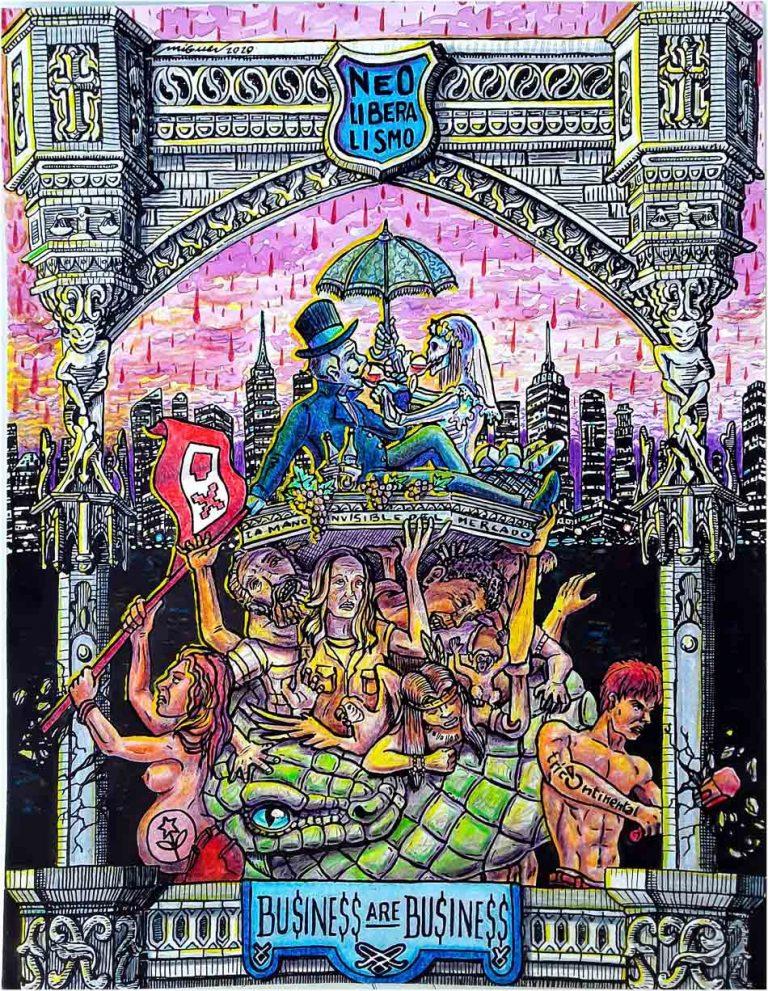
<Miguel Guerra (Venezuela), Estructura de Opresión (âStructure of Oppressionâ), 2020>
The artwork for the Anti-Imperialist Poster Exhibition II: Neoliberalism allows us to see different views of the same problem in different languages, cultures and regions. This is art. Art allows us to share with others the good and the bad things that happen, reflecting on the experiences of a culture, a people and a class and bringing them to a personal level; it is about building a common language amongst those who identify with the work that is shared.
The exhibition features posters created in a variety of manners – using the most sophisticated design software, manual techniques, and hybrid methods. This diversity foregrounds the question of access to resources and at the same time the conditions of production.
We chose to highlight work crafted by hand because we live in a world that is so technologically-mediated that it sometimes stops us from creating – and seeing – art that is created by hand. We fear that the handcrafted work is not perfect, or that it is not technically sophisticated enough; as a result, we forfeit manual tools, which are often more accessible, in the battle of ideas and the struggle of the working class. We miss opportunities to see pieces that are as good and as diverse as the ones that we see in this exhibition.
Work done by hand not only amplifies the possibilities of expression, but it helps connect the ideas conveyed to our subjectivity. When preparing the poster by hand, we engage and activate the body in a way that digital work does not allow. We feel the strong gestures in the hand-painted work of Ciara Taylor (Popular Education Project, United States), the detailed motions of migration in Labani Jangi’s painting (People’s Archive of Rural India, India), the organic curves of human suffering in Deivisom Shirmer de Lima’s poster (Associação de Moradores do Bairro Riveira, Brazil).
As a curatorial decision, we chose not to judge and analyze the posters based on bourgeois standards of aesthetics and technique; rather, we chose to judge them by their ability to convey visions of a concrete reality of people’s global struggles against neoliberalism.
Extractivism

<Roland Nalukoma Cubaka (Congo Love, Democratic Republic of Congo), Lâenrichissement illicite des riches à travers la guerre et exploitation des minerais (âThe illegal enrichment of the wealthy through war and the exploitation of mineralsâ), 2020>
Capitalist exploitation and its relations of production only deepen in the peripheral territories, where there is a reservoir of surplus labor, natural resources, and social goods. So goes the logic of capitalism in its stage of imperialist expansion.
Capitalism since its inception has been based in the logic of self-expansion, which is to say that capital only serves to accumulate more capital, and for this it has subsumed all of the social relations of production, distribution and exchange.
However, in its most recent phase, ‘accumulation through dispossession’, capital is increasingly putting the survival of the planet and humanity at risk. The amplified reproduction of capital has meant the mercantilization of all aspects of life and all natural resources that allow for the development of humanity, from water and nature to health and education.
Accumulation through dispossession was clearly consolidated with the neoliberal offensive of the 1990s and the extractivist-export model, with privatizations and tremendous advances in the commercialization of public and natural goods.
Extractivism knows no borders. In this exhibition, we see this theme recurring from mineral resources of Papua to the Congo, from the commons of Cape Verde to Brazil.
Privatization

<Kelana Destin (Indonesia), Water, 2020>
Privatization will not allow for the water and the trees, nor for the soil and the fruits of the world to service the needs of humanity. To profit, the ruling class must privatize that which we need to survive and make with our labor becomes theirs. All that has a common use cannot stay freely with the people, nor can it be used for the common good.
Neoliberalism ‘socializes losses and privatizes gains’, as Jeremy Kane (Chicago DSA, USA) visualizes it in his poster USA. A pillar of this domination is the compulsion to privatize all that is socially owned for the common good. Centuries in the making, there has been a slow and painful shift from publicly to privately produced goods and services. Programs that serve the public interest are gradually phased out and social welfare is no longer a responsibility of those who are elected.
To eat becomes a privilege of one class, made up of vultures in suits, as demonstrated by Jorge González Morales (Mexico) in his poster Bienes comunes (‘Common goods’). Hospitals are transformed, with every bed and machine treated as real estate for maximizing rent collection. Education becomes about creating more sellable labor as the great centers of learning tie sandbags of debt to the ankles of young people. Nations colonized become meat to be sold and traded on the global market; Puerto Rico is packaged in Styrofoam in Malena Vargas Sáez’s poster, Lista para su consume (‘Ready for your consumption’). Whole continents, their people, and the very air they breathe, are on sale; Kalia Venereo (Cuba) serves us Latin America on a platter in her poster, ON SALE. This is privatization.
As Seraphina Yoku shows in Republic of Investor (Papua-Indonesia), the barrel of a gun hovers into view should we dare to resist. When we ask questions, the mobile drug dispensary is wheeled out and a big pill distributed for our consumption in Priscila Adamo’s (Argentina) Contraindicaciones (‘Contraindications’).
What remains for the people of the world? Collecting fallen branches for wood-fired heating becomes a crime. Towering walls are erected to keep property safe from the ‘greedy’ hands of the starving populations who have the audacity to attempt to stay alive. Men in boots trample on our backs and press down on the necks of the people.
Austerity
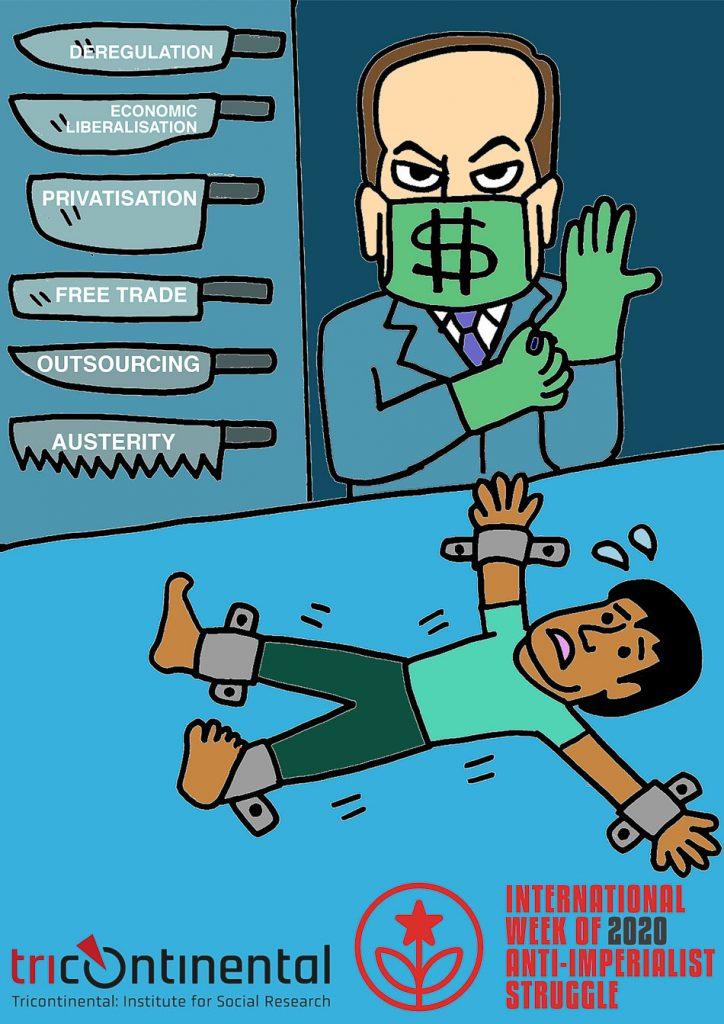
<Choo Chon Kai (Parti Sosialis Malaysia, Malaysia), Freedom of choice?, 2020>
‘They cut, we bleed’. The bold text in Robert Streader’s poster (Young Communist League of Britain, Great Britain) sums up the underpinnings of austerity; it is part and parcel of neoliberal economic policy. The slashing of the public sector is more than the sterile process through which bureaucrats add and subtract numbers and write convincing arguments in a budget report. It is a violent process. It is the tearing away of resources and services that the state should be providing for its people, leaving them less protected and less stable, and therefore vulnerable to any crisis.
Austerity economics have time and time again proved to be a failure, yet the mighty scissors of the international financial institutions continue to move at a rapid speed. While states advise their people to wear masks, wash their hands, and stay inside, they simultaneously tell people that there will be no more state-funded social support; instead, they are told that they should just work harder.
One of the biggest lies of austerity is the notion that people are somehow demanding things for free, but as brilliantly visualized in Kelana Destin’s poster, Water, these are the resources of the people.
Financialization
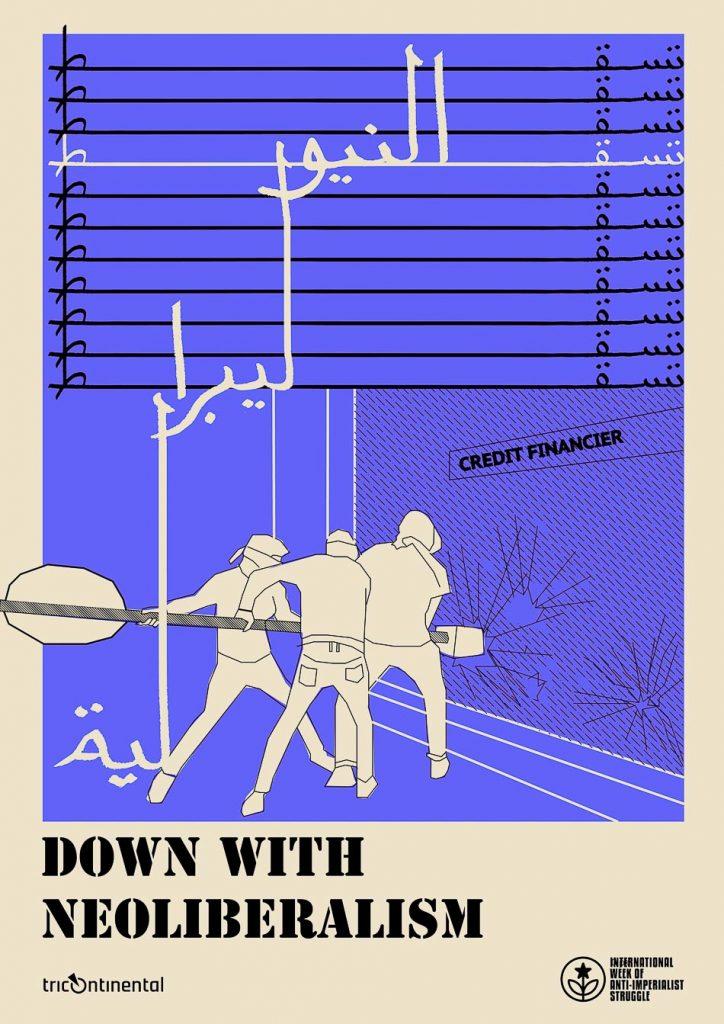
<Nancy Naser Al Deen (Lebanon), Down with neoliberalism, 2020>
The global ruling class knows that it is morally bankrupt. It tries to compensate for its political bankruptcy by playing the chords of morality, philanthropy, and human rights. Non-governmental organizations (NGOs) and the institutions owned by billionaires, whose names they often bear, lend the ruling class moral authority that it does not deserve. They know that what they have accumulated is a clear expression of their corruption; it overwhelms them to the soles of their feet.
While the ultra-rich keep their wealth in off-shore accounts evading taxes with ease, it is the poor who bear the consequences. The oppressed classes do not benefit from the services that the state is supposed to provide them. In the era of neoliberalism, capital has shifted almost entirely to the speculative financial sector to increase its wealth, thereby placing a time bomb beneath the foundation of the entire capitalist system. In Fabiola Sánchez Quiroz’s (Jovenes ante la Emergencia Nacional, Mexico) poster, the bull that sits on Wall Street seems to forebode where this speculative capital is headed.
Under the neoliberal model, huge profits are made and huge wealth accumulated in the hands of speculators, a process detached from production. This has left us with a phenomenon called ‘profits without production’.
There are now deep structural imbalances in the global capitalist economy. The most prominent – and dangerous – is the imbalance between the massive quantity of accumulated financial capital and the real economy, the sector that produces goods and creates real wealth.
Under neoliberalism, financial markets began to grow independently of actual financing needs. Custody of the global economy has shifted from the hands of investors and entrepreneurs of the real economy to the financial managers and market experts of the virtual economy, far removed from the production process. In light of all of this, the role of the state has been reduced to the field of monetary policy in order to combat inflation. The state has abandoned the task of protecting the economy and, more often, its people.
Hope and Resistance
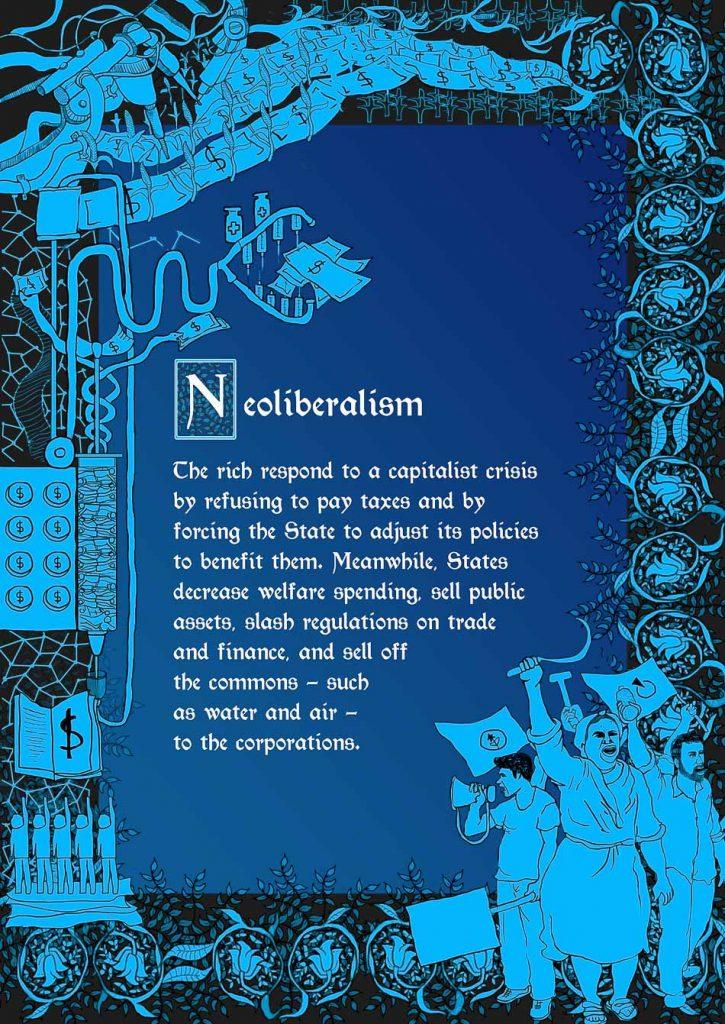
<Vikas Thakur (Tricontinental: Institute for Social Research, India), Neoliberalism, 2020>
Hope emerges in acts of resistance against neoliberalism. Hope emerges from the people as they struggle for a new society – one that places the interests of humanity over corporate profits. The artwork for the Anti-Imperialist Poster Exhibition II: Neoliberalism visualizes the impacts of neoliberalism on our way of life and offers the glimmers of hope emerging from peoples’ struggles.
The beauty of this set of posters in large part emanates from the unique ways that these artists use color and imagery to portray resistance and hope.
Obed Mayambau Ngama (Congo Love, Democratic Republic of Congo) uses colors to depict the dark abyss of neoliberalism, the poisonous effects of this ideology, and the worker struggling against the weight of corporate exploitation. Adeeb Hamdan (Palestinian Democratic Youth Union, Palestine) makes use of colors to highlight and accent the Palestinian people’s resistance to the terror and oppression inflicted by Israel and sponsored by the United States. Gerónimo Dellacasa (Argentina) uses different shades of color to depict the clash between the oppressed and neoliberal oppressors.
The detailed imagery in Philani Emmanuel Mhlungu’s (Socialist Revolutionary Worker’s Party/Soweto Action Committee, South Africa) hand-drawn artwork depicts the people’s struggles against neoliberalism and towards a future of socialism. Judy Seidman (South Africa) illustrates working-class mistica and colorfully depicts the oppressed joining hands together in struggle. Danny Isham (Red Star Rising, United States) uses a line of demarcation to show that workers stand on the right side of history against the free market policies of neoliberalism. Haydar Özay (Turkey) creates a fierce portrait of Karl Marx and his text which continue to enlighten our movements and people’s struggles throughout the world. The collective Un Mundo Feliz (Spain) presents the Euro symbol superimposed with the female symbol, warning us that we cannot let neoliberalism reduce feminism into a commodity. We must put those who are at the center of exploitation at the center of struggle. Feminism will be anti-capitalist or it won’t be at all.
The importance of these posters is that they show that neoliberalism will not end without a concerted and organized effort from the people. These posters powerfully capture the struggles of today and the fight to end neoliberalism for the sake of humanity.
This text was prepared collectively by the curation team of the Anti-Imperialist Poster Exhibition:
Luciana Balbuena, Tricontinental: Institute for Social Research (Argentina)
Gabriela Barraza, Escuela José Carlos Mariátegui (Argentina)
Ibnou Ali Abdelouahad, Democratic Way (Morocco)
Tings Chak, Tricontinental: Institute for Social Research (China)
David Chung, The People’s Forum (USA)
Sudhanva Deshpande, LeftWord Books (India)
Ingrid Neves, Tricontinental: Institute for Social Research (Brazil)
Mikaela Nhondo Erskog, Socialist Revolutionary Workers Party (South Africa)
Nora García Nieves, Partido Comunista de España (Spain)
Zoe PC, International Peoples’ Assembly and Peoples Dispatch
Ambedkar Pindiga, Tricontinental: Institute for Social Research (India)
Get the latest reports & analysis with people's perspective on Protests, movements & deep analytical videos, discussions of the current affairs in your Telegram app. Subscribe to NewsClick's Telegram channel & get Real-Time updates on stories, as they get published on our website.















